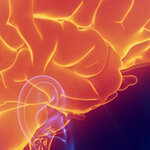Aging

Older brains are more similar to younger brains than previously thought, according to a new study.
Certainly, brains change as we get older. People get dementia and that is linked to plaque build-up, but that is not neuronal activity, as some papers using functional magnetic resonance imaging (fMRI) have claimed. Instead, it may be due to vascular (blood vessel) changes.
Since fMRI is frequenly used (and misused) in studies to assess aging, this could have important consequences for mainstream media's ability to promote a new theory of aging once a month.
A fundamental…

Doctors are writing lots of prescriptions for drugs to calm the behavior of people with Alzheimer's disease and other types of dementia, but non-drug approaches work better and carry far fewer risks, according to a new paper.
In contrast to current protocol non-drug approaches should be the first choice for treating dementia patients' common symptoms such as irritability, agitation, depression, anxiety, sleep problems, aggression, apathy and delusions, write a team in British Medical Journal after reviewing two decades' worth of research on antipsychotics, antidepressants and non-drug…

A new paper based on a study of 4,219 people without any evidence of blood cancer nonetheless found that up to 20 percent of people aged 50-60 and more than 70 percent of people over 90 have blood cells with the same gene changes as found in leukemia.
That means it is almost inevitable that we will develop genetic mutations associated with leukemia as we age, according to the authors investigating the earliest stages of cancer development used an exquisitely sensitive sequencing method capable of detecting DNA mutations present in as few as 1.6 percent of blood cells, to analyze…

Amyloid, an abnormal protein whose accumulation in the brain is a hallmark of Alzheimer's disease, starts accumulating inside neurons of people as young as 20, a much younger age than scientists ever imagined, according to a new study based on brains obtained from the Northwestern University Alzheimer's Disease Center Brain Bank and from pathologists throughout the United States.
Scientists believe this is the first time amyloid accumulation has been shown in such young human brains. It's long been known that amyloid accumulates and forms clumps of plaque outside neurons in aging…

Faced with an increased senior population and a dwindling working age one, government accountants have spread the word that elderly people need to be encouraged to work longer.
And they are being encouraged, by changes in pension policies that force them to do so. As a result, a social safety net that was designed to reduce retirement inequality nearly a century ago is once again increasing it - some groups are more likely to be disadvantaged by a rise in the state retirement age than others, because some people are more able to work as senior citizens than others.
The big factors are…
Youth may be idealized but that doesn't mean older people aren't getting busy - they just don't take pictures on their cell phones and post them to Instagram. A new survey found that people in the early years of marriage have sex more frequently, and sexual activity tapers off over time, but then a rebound occurs after 50 years.
That is comforting, but how many people do you know who have been married 50 years? Right, not many, and that number is going to go down. But more relevant is that if people want more sex, they should stay married, in defiance of modern wisdom. Second marriages lead…
Despite the claims of people selling books on ascension into being robots or diet fads, you are not going to live forever.
It used to be life was truly short and now we are in a period where life is much longer but after the age of 65 it is not better, it is instead a slow steady decline toward death.
The goal cannot be to try and live forever, nature has built in too many biological landmines to control that, but to live healthier until we do die. First, we'd have to agree on what this 'successful' aging would look like, without wellness psychobabble.
In the latest issue of The…

I read a sad story in the news recently. A Baltimore mother died a week after giving birth to two twin sons, leaving her husband to raise the two boys on his own.
As tragic as the news was, the reason that it made national headlines was that the mother was 56 years old. Initial reports indicate that her death was the result of a bowel obstruction, not because of the pregnancy, but a lot of the coverage of this story has focused on one question: how old is too old to give birth?
20 years ago, this would not have even been a question at all, because the usual maximum age when childbirth…

Osteoporosis is the most common type of bone disease, it is characterized by bones becoming so weak and brittle a simple cough can cause a fracture. About half of all women over the age of 50 are at risk.
It is preventable but for those who have it, existing treatments for this pathological bone loss mean inhibiting osteoclasts (bone-destroying cells) to limit bone degradation - but by doing so, they also prevent bone formation since it is stimulated by the presence of these very same osteoclast cells.
Researchers from the CNRS, Inserm and the Université de Montpellier and…

Like most things, age is the biggest risk factor for complications in pregnancy. When the expectant mother is over 35, the risks associated with overweight, smoking, gestational diabetes and pre-eclampsia also become higher, according to a register-based analysis from the University of Eastern Finland.
Advanced maternal age has been a growing trend over the past few decades. In Finland, the authors note, 20 percent of mothers in 2013 were over 35 years old. Fertility drugs and IVF have made motherhood possible at almost any age and increased popularity of 'egg freezing' is likely to…